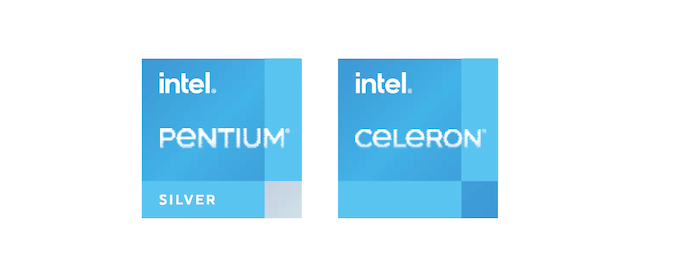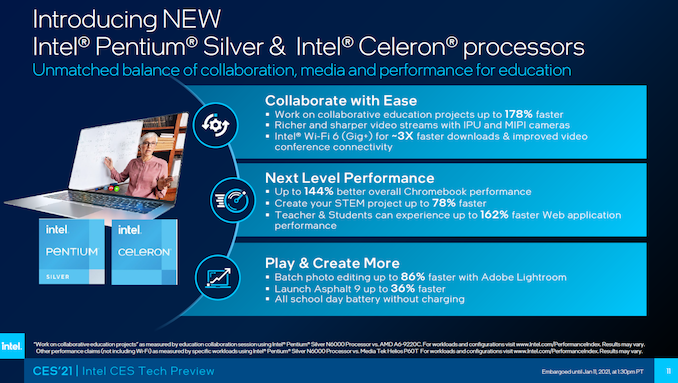Intel Launches Jasper Lake: Tremont Atom Cores For All
by Dr. Ian Cutress on January 11, 2021 4:30 PM EST
One of the more interesting elements in Intel’s 2020 set of disclosures was its 10nm Tremont Atom core. Initially used in the low power Lakefield product, this core design is super interesting due to its dual decoder design, which no other x86 core does. It has been over a year since the launch of Lakefield, and we’ve been hoping for a friendlier platform on which to test these new cores, along with some extra frequency to see the design stretch its legs. That platform is launching today, with Intel’s newest Pentium Silver and Celeron Processors.
The new Pentium Silver and Celeron processors are aimed initially at the education market, and Chromebooks, but will slowly expand into Linux and Windows variants over time. Intel detailed that the laptop market was priority over the mini-PC market, however other form factors are free to be developed. These new processors will follow the same schema as Atom-based Pentium and Celeron processors in the past, with quad-core and dual-core variants on offer. Intel has detailed six processors in total, three each at the 10W and 6W levels.
| Intel Jasper Lake | ||||||
| AnandTech | Cores Threads |
Base Freq |
Turbo Freq |
DDR4 LP4X |
GPU | GPU Freq |
| 10 W TDP | ||||||
| Pentium N6005 | 4C / 4T | 2000 | 3300 | 2933 | UHD | 900 |
| Celeron N5105 | 4C / 4T | 2000 | 2900 | 2933 | UHD | 800 |
| Celeron N4505 | 2C / 2T | 2000 | 2900 | 2933 | UHD | 750 |
| 6 W TDP | ||||||
| Pentium N6000 | 4C / 4T | 1100 | 3300 | 2933 | UHD | 850 |
| Celeron N5100 | 4C / 4T | 1100 | 2800 | 2933 | UHD | 800 |
| Celeron N4500 | 2C / 2T | 1100 | 2800 | 2933 | UHD | 750 |
All the processors will feature 1.5 MB of inclusive shared L2 cache, as Tremont is built around quad-core modules sharing an L2 cache – in this instance the dual-core variants simply have two cores disabled, but full access to the L2 cache. There is also 4 MB of non-inclusive shared L3 cache, which is a sizeable cache for an entry-level processor.
You can read the deep dive into the Tremont microarchitecture here.
All the CPUs support dual channel DDR4-2933, as well as LPDDR4X-2933, which is an odd combination as usually the LPDDR4X transfer rate is higher, such as LPDDR4X-3600. Graphics is provided by Intel’s UHD design, however it isn’t stated if this is Gen or Xe graphics, nor how many EUs these parts have. Through the stack we see a turbo frequency of 3.3 GHz, but Intel doesn’t specify base frequencies. In the footnotes, it does state that the turbo power is 20 W for the 6 W variants.
*Update: Intel's own specifications site, ARK, is now listing the base frequencies. We also have been told that the graphics are Gen11, not Xe.
A new features coming to these processors is Intel’s Image Processing Unit, or IPU, which when paired with a MIPI interface can enable accelerated compute for video calls and techniques, such as blurred backgrounds. Coupled with Wi-Fi 6 support (via additional RF), and the goal here is to provide a machine that can enable an education type workload.
The initial devices with these processors will be Chromebooks, which Intel compares itself favourably to AMD's A6-9220C, and MediaTek’s Helios P60T. Intel states a 35% generational improvement over Gemini Lake, and 144% better Chromebook performance (using PT’s CrXPRT benchmark) over the competition. Intel expects these devices to be in the market in Q1. Linux and Windows based devices are expected in Q2. Intel states that it will have 170 Chromebook designs in 2021, of which these processors will form a part of that mix.
Related Reading
- Interview with Intel CEO Bob Swan
- Intel at CES 2021: Overview
- Intel at CES 2021: Press Event Live Blog
- Intel Ice Lake Xeon in Production
- Intel 11th Gen Desktop Rocket Lake Core i9-11900K ‘Preview’
- Intel 11th Gen Tiger Lake-U Boosted to 35W
- Intel 11th Gen Tiger Lake-H with 8 cores
- Intel 11th Gen Tiger Lake Goes vPro
- Intel’s Next Gen Tremont Atom in Jasper Lake for Q1











31 Comments
View All Comments
spacebeer - Tuesday, January 12, 2021 - link
Yes, 3015e, 3020e & 3050ehttps://www.anandtech.com/show/15953/amd-zen-now-a...
mode_13h - Tuesday, January 12, 2021 - link
Fair enough. That would be an interesting head-to-head. With 32 Gen11 EUs, I think Intel's Pentium Silver N6000 would easily beat Vega 3. However, it's less clear to me who would win on CPU performance, though I'd also give a nod to Intel for competing with 4 full cores.I'm also curious about how pricing would compare.
iwannadoit2 - Tuesday, January 12, 2021 - link
It would be good if AnandTech can benchmark Zen 6W with these Jasper Lake 6W processors. Interestingly AMD only released 15W SKUs for Chrome (3050c, 3150c).https://www.amd.com/en/processors/chromebook
Zen 6W seem to be limited for Windows
Namisecond - Friday, January 15, 2021 - link
Only at the base 6W TDP. At the higher 20W Turbo TDP, no contest. However, this chip isn't meant for $600+ laptops. It's meant for for the $350-ish netbook and chromebook market. At a 35% performance improvement over the last gen, It does sound reasonably compelling.Spunjji - Tuesday, January 12, 2021 - link
I noticed that too. Competing against ancient tech, not a great look!iwannadoit2 - Wednesday, January 13, 2021 - link
No AMD Zen chromebooks available in the market either. You all don't seem follow Chromebook market. Other than Intel's processors, I see only AMD's A6/A4 and MediaTek's P60T- in the market. 2021 will be different and AnandTech should compare Jasper Lake with AMD 3150c (but is 15W fair comparison?) and MTK 8192/8195 after they come out.mikk - Monday, January 11, 2021 - link
It's Gen11 based which was already known. No AV1 hardware support unfortunately.tomli747 - Monday, January 11, 2021 - link
Isn't the N4505 2C2T?mode_13h - Tuesday, January 12, 2021 - link
I'm just glad to see Tremont-based CPUs finally launch (not counting oddball Lakefield).I have an Apollo Lake box and it's fine for certain things, like light-duty server and streaming. Tremont should be a substantial upgrade.
Software support (including GPU) worked flawlessly, for me. That's a definite advantage Intel still holds over most ARM-based competitors.
CiccioB - Tuesday, January 12, 2021 - link
Yeah,time time to upgrade the old D510 file server!
We had to wait sooo long to have new low power chips like these.
Now I'll wait for the mini ITX boards.